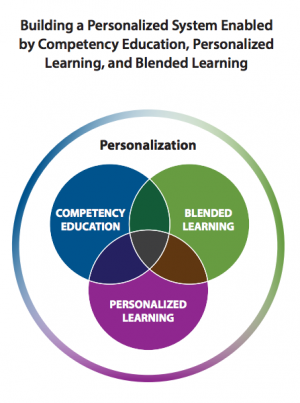Many teachers have long been frustrated with static, canned curriculum that doesn’t seem connected to kids' lives, and testing requirements that drive the learning experience. So they, often in partnership with daring leaders, are pushing back, trying to find ways to meet the long-held goal of educators: Meeting each student’s needs and helping all to be successful. Three main ways schools are attempting this work are through technology use, an emphasis on personalizing learning and moving toward a mastery-based or competency-based evaluation system. While not all the same, these approaches share some commonalities and require significant structural changes to the education system if they are to be implemented well.
A CompetencyWorks report, “Maximizing Competency Education and Blended Learning: Insights from Experts,” looks at ways that the movement for personalization dovetails with blended learning and competency-based learning to achieve a more student-centered approach to school. The report also identifies some key system changes that would support the grass-roots work that has already begun.
The report defines personalized learning as “tailor[ing] learning to students’ strengths, needs, interests and experiences.” The authors are careful to point out that adaptive learning software that allows self-paced learning is not the same thing as personalized learning. Good teachers are crucial to help students identify their learning strengths and weaknesses, to offer various learning modalities and to push students to apply their learning to their personal interests. No two students are the same, and a personalized model recognizes the same tools and approaches won’t be appropriate for every student.
Competency education refers to a break from the traditional time-based school model. Rather than moving students on to the next grade with their age-based cohort, regardless of gaps in their foundational knowledge, educators allow students to move on only when they have demonstrated mastery of topics. This can lead to a chaotic classroom, with students at many different stages in their learning, which is partly why many competency-based schools rely on technology to help meet students' varied needs along the way.
“If we just keep doing what we’re doing today, we are still going to end up with kids with huge gaps, even if they advance incrementally,” said Susan Patrick, president and CEO of the International Association for K-12 Online Learning (iNACOL) and co-author of the report. She notes that some critics of competency education worry it will widen opportunity gaps as advanced students move quickly ahead, leaving struggling students even further behind. Patrick says that shouldn’t happen if teachers hold all students to high standards and make sure to examine data on student learning every day.



